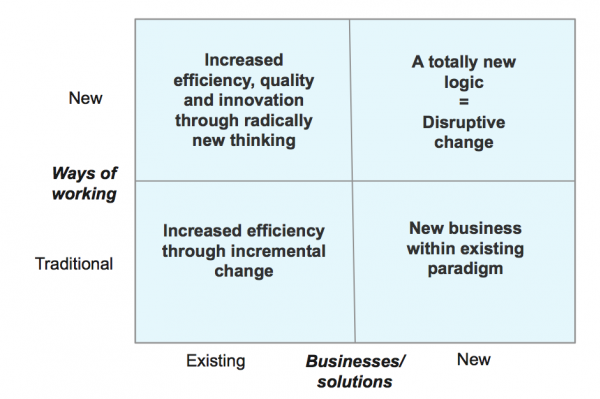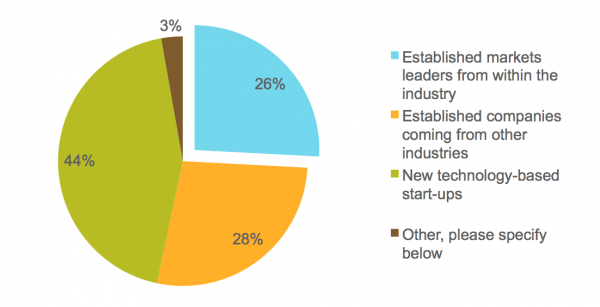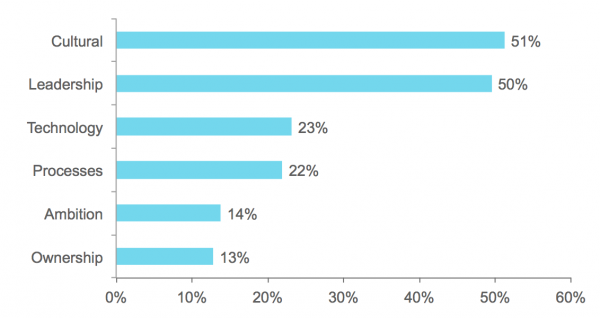Digital and disruptive – four key factors for digital leaders
Digitization is scaling up to a whole new level and these shifts may, in turn, bring dramatic changes to the very foundation of the business landscape, also known as disruptive change.
We live in a time of revolutionary digitization. Big data, machine learning, autonomous systems, cloud-based services, Internet of Things, virtual reality, augmented reality and robotization. Digitization is scaling up to a whole new level. Many argue that the phase digitization is in now means that most businesses will face radical shifts. These shifts may, in turn, bring dramatic changes to the very foundation of the business landscape, also known as disruptive change.
Digitization means change
New technology and new equipment has always meant change. People and organizations have been forced to change ingrained practices and embrace new solutions. If we zoom out to take a look at the development we see two clear parallel paths of development created by digital possibilities:
- Digitization affects the external delivery/business model. The creation of value itself (and thereby the organizations reason of existence) is altered when digitization affects what the organization delivers.
- Digitization affects the internal production. The digitization opens up for possibilities to change how you process and deliver products and services, in other words how you deliver value to customers and users.
These can be combined and we see four main patterns that an organization often undergoes when digitization strikes.

At the same time, we see in many surveys that although many leaders say they have the ambition to change both working methods and be open to new business or business logics, the vast majority are not able to emerge from the lower left corner of the diagram. The digital tools are used mainly in the context of existing solutions, and with the old approach. The revolution fails and the big profits likewise.
Business model innovation
When Kairos Future asked Nordic business leaders how long they believe that their current offerings will be relevant, almost a fifth said that they probably had less than two years to find new business models and another fifty per cent estimated that their offerings would be obsolete in three to five years. We can see in the answers in this study that there is an expectation of acceleration in the development of new business models. When the business leaders look into the future, 38 per cent assume they have a disruptive change ahead of them the next five years, whereas only 17 per cent would describe the last five year period as disruptive.
A central part of the changing business models is about the change in value of qualitative raw data. Those who manage to collect and process data in the best way possible have everything on their side to profit from the opportunities of digitization. In addition, it plays a decisive role who is in control of the platforms where data is collected, stored and analyzed. More or less all organizations today have management systems, CRM systems, etc., and these systems are now rapidly consolidated to large-scale platform owners. This brings a threat along, for example, for the public sector, which lacks its own investment capital, risking being forced to enter into agreements with system suppliers that give them cheaper system support in exchange for receiving data in return.
Change comes from elsewhere than the traditional players
A third interesting conclusion from Kairos Future’s study is which actors business leaders of today believe will drive the disruptive change. Only a fourth of the business leaders are of the opinion that change is fuelled but the established competitors, and about as many argue that disruption will come from established actors in different sectors moving into new sectors. Half of the respondents were convinced that change would rather be driven by new actors, mainly technology based start-ups.

Nordic business leaders’ view of what actors that drive disruptive change
Digital tools are already a natural part of basically every organization. But even if it may seem as if the digital world is well integrated, the digital transformation ahead of us is of another nature and is well worthy its own acknowledgement. They ways of logging data, analyzing data and the computing power that drives automation, robotization, internet of things and virtual reality may very well bring change as revolutionary as when computers first entered our work places.
Leading digital transformation
For a long time, most organizations viewed the digital as something that the IT department should deal with. However, a few years after 2000 you could notice a change, and people started talking about the need for a digital strategy. In practice, the new strategy was not longer about the digital tools and support systems needed, but about what new services and solutions an organization could offer when strengthened with digital solutions. Only recently, in the last two years, many organizations have realized that a digital strategy is not enough. Instead, you need a main strategy for the whole organization that starts in the idea of a business environment where digital is part of the air we breathe. This is a given thing for many organizations, but at the same time, we see little too often examples of those who have not yet taken that step. And then it starts to be high time, otherwise you risk inevitably be overtaken.
A strategy for a digital reality
Strategy for digitization is a recurrent theme when studying key factors behind successful digital transformations. Some would even argue that a good strategy is a much more powerful driving force behind digitization than the digital technology itself. An international study showed that while both digitally mature companies and digitally immature companies use digital tools to some extent, they differ substantially when it comes to strategy. While more than 80 per cent of the digitally mature companies have a digital strategy, only fifteen percent of the digitally immature companies have something similar. In addition, the different strategies are different in nature. While digitally immature companies have strategies of how they want to integrate digital support systems in their current processes, the digitally mature companies take on a wider perspective and develop strategies that will help them re-engineer their whole business model and even their business landscape.
In a study performed by Kairos Future (not yet published), more than 500 Nordic business managers rated what they see as the largest challenges in succeeding with the threats and possibilities that digitization brings. These managers identified culture and leadership as the dominant factors. It is, in other words, not so much about technology or processes, but rather about getting people involved and to strive for the same goal.

Leadership for digitization
The question all business leaders should ask themselves is, in other words, if the leadership and culture needed to benefit from the possibilities of digitization are in place. One of the most important factors highlighted in studies on digital transformation is that it is a matter for the CEO and the board, and that they cannot, under any circumstances, delegate such an important and strategic aspect to the IT department.
To transfer an organization to digital inevitably leads to some painful changes for individuals in the organization. Roles change to be less influential, some managers get less power and some get more, resources are reorganised and there is a larger demand put on speed and agility. This management challenge is, in itself, a sign of the things that characterize digitization – it breaks up silos where we used to feel safe and forces us into areas which are new to us.
Close to half of all the mangers, regardless of whether or not they have a role in IT, have been part of making strategic decisions regarding digitization. It comes as no surprise that over half of these managers (managers who took part in IT decisions which lack formal IT education) say that they do not feel that they have the right competence to make such decisions. No matter if you feel ready or not, more and more mangers will be involved in decisions regarding digitization. Therefore it becomes crucial to educate all decision makers in the foundation and possibilities that digitization brings. But how then should one act and lead in order to be a good digital leader?
Four key factors for digital leaders
Ideally the CEO leads the transformation towards becoming a digital organization. To manage such a disruptive change calls for a strong and resilient leadership which dares to make the uncomfortable decisions and to enact necessary organizational changes, power shifts and cultural changes . But, at the same time as the CEO is at the core of digital transformation, digitization puts pressure on all leaders in the organization to change into a digital and innovative mind-set. Four key factors can be circled in terms of leadership for digital transformation.
- A holistic perspective. Break up silos, dissolve territories, and hire generalists who understand the whole picture and the business to work at the core of the digital transformation.
- Say goodbye to old truths. Be quick in understanding what competencies and departments will become obsolete in the transformation and train them to better fit the new paradigm.
- Speed and innovation. Maker sure your old processes do not slow down the digital development. Digital innovation can happen at a faster speed than innovation in hardware and is therefore expected to be quick. Since digitization will be part of every corner of your organization, the whole organization will also be expected to innovate.
- Vision and strategy over control. Visions, strategies and frameworks benefits innovation – control wears it down. Set ambitious targets that inspire to completely new ways of working. Turn all leaders into leaders of innovation.
Would you like to know more about how to adjust to disruptive change? Please contact Erik Herngren. This article is written by Erik Herngren and is based on the report produced for the members of the network Kairos Future Club, read more about membership here.
